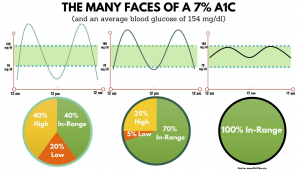 November is American Diabetes Month, and today, Nov. 14, 2020 is World Diabetes Day. This is a time to take action together to raise awareness and draw attention to the importance of proper diabetes education. Learn more at www.diabetes.org and www.worlddiabetesday.org.
November is American Diabetes Month, and today, Nov. 14, 2020 is World Diabetes Day. This is a time to take action together to raise awareness and draw attention to the importance of proper diabetes education. Learn more at www.diabetes.org and www.worlddiabetesday.org.
Just when we were all getting familiar with our A1C levels, a fairly new buzz-worthy phrase has emerged in relation to diabetes control, and that’s “time-in-range.” What “range” do the experts mean? According to the American Diabetes Association, it’s your target range for blood glucose (BG) levels and is generally 70 to 180 mg/dl. This includes BG readings before meals and after meals.
If you’re not familiar with time-in-range (TIR) now, you will be soon. As the adoption of continuous glucose monitors (CGM) continues to increase, you’ll see more people talking about TIR. The only way to accurately measure TIR is by continuously monitoring your blood glucose with a CGM, which will show you the history of your BG, not just a snapshot in time like a fingerstick measures. This information helps you identify trends and manage your diabetes more confidently.
Now that we know the target range is 70 to 180 mg/dl, the next step is to determine at what percentage of the day should you be within this range. What is a reasonable percentage? Should it be 100% of the time? Should it be 90% of the time?
Ultimately the answer depends on where you’re starting. For example, if you are in the range 50% of the time, then aim 60% of the time. Also, know that your medication regimen may also make achieving a high percent more challenging, and you and your healthcare team may choose a lower TIR goal. Managing diabetes is always individualized, and identifying TIR goals is no different.
And that achieving that TIR goal isn’t your only objective. Let’s say that you have a 90% TIR, which sounds great, right? But if the other 10% of the time your blood sugar is less than 70, you run the risk of hypoglycemic episodes that could be dangerous and should be avoided. Your goal, then, would be to work on avoiding the lows, even if it means that your percent time in range is a little lower, especially at first. Ideally, you want your time below 70 to be no greater than 3%. If you are having BG less than 70 more often than 3% of the time, it is likely time to reduce a medication that can cause lows.
As people with diabetes will know, most doctors judge your degree of blood sugar control on your A1C, which is based on the average blood sugar level over a three-month period. If you are using a CGM, you may wonder which is more important, TIR or A1C?
A1C has a well-known relationship with the risk of complications. Risks for things like kidney issues, eye problems, vascular, and nerve problems increase as the A1C goes up. But the problem with A1C is that it is an average of your blood sugar! You might be averaging very high numbers with very low numbers. These swings in blood sugar are not healthy.
Consider the chart below from DiaTribe. It shows the limitations of only looking at A1C results. As you can see, each graphic shows a different time-in-range, but they all have the same A1C of 7.0% (an average BG of 154mg/dl). Because we want to limit highs and slows, the third graphic with a 100% TIR is optimal.
CGM users are finding that they are empowered when knowing their BG levels immediately. With the advent of the CGM, waiting three months to find out how you’re doing is no longer status quo. At GemCare Wellness, we work with many people who have diabetes and use CGM along with health coaching from us to help manage their condition:
Gloria P. has recently said that she is now aware of the “evil carbs.” The CGM helped her recognize that “all carbs are not created equal” and that certain carbs impacted her blood sugar more than others. Since then, she has tried to limit use of rice, apples, and corn because they act as “bad carbs” for her, even in small portions.
Jason M. found that he could lower his medication use now that he has the CGM. By being aware of the changes in his blood glucose levels, he changed his diet and added exercise when his blood sugar was on the rise. He’s now reduced his medications in half, has better control, and is even saving money with lower medication costs! He reports that “all is good! I am saving money on meds and improving my lifestyle.”
Both of these individuals have successfully improved their time-in-range and now are awaiting that three-month A1C check. Hopefully, that number will make them proud — we’re already proud of them for all the work they’ve done to improve their health.
If you’re interested in working with GemCare Wellness, please contact us today to set up a consultation! Whether you’re an individual looking to improve your health or an employer focused on a healthier population, GemCare Wellness has a program to fit your needs!


